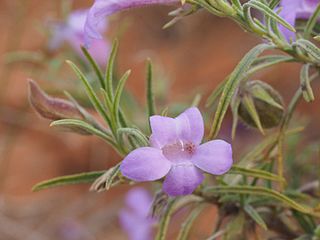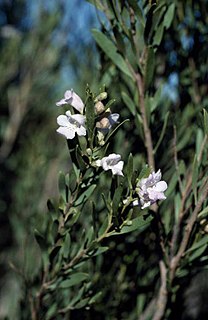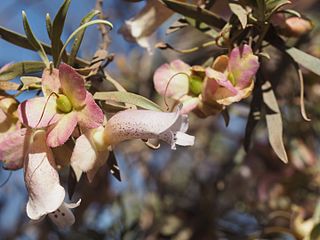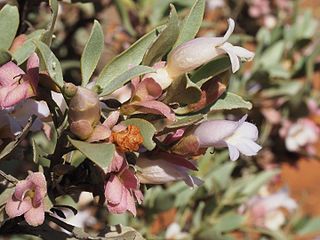
Eremophila youngii is a flowering plant in the figwort family, Scrophulariaceae and is endemic to Western Australia. It is a dense, erect shrub with many of its parts covered with a layer of grey to yellowish-grey scales and with pink, purple or red flowers.

Eremophila divaricata, also known as spreading emu bush, is a flowering plant in the figwort family, Scrophulariaceae and is endemic to Australia. It is a shrub with stiff, spreading, tangled branches which are often spiny on their ends, erect leaves and mauve to lilac-coloured flowers.

Eremophila oldfieldii, commonly known as pixie bush, is a flowering plant in the figwort family, Scrophulariaceae and is endemic to Western Australia. It is a shrub or small tree with rough bark, broad, flat or narrow fleshy leaves and red, orange or yellow flowers.

Eremophila latrobei, commonly known as crimson turkey bush, native fuchsia, Latrobe's emu bush, grey fuchsia bush, warty fuchsia bush and Georgina poison bush is a flowering plant in the figwort family, Scrophulariaceae and is endemic to Australia. It is an erect, highly branched shrub with usually linear leaves and red to purple-red flowers and which occurs in all mainland states, including the Northern Territory but excluding Victoria.

Eremophila fraseri, commonly known as burra or jilarnu, is a flowering plant in the figwort family, Scrophulariaceae and is endemic to Western Australia. It is a shrub or small tree with all above-ground parts of the plant, apart from the petals, sticky and shiny due to the presence of a large amount of resin. The petals are coloured white, cream, pink and brown.

Eremophila hughesii is a flowering plant in the figwort family, Scrophulariaceae and is endemic to Australia. It is spindly, glabrous shrub with narrow leaves and with flowers that vary in colour from blue to pink, sometimes white. It is native to Western Australia and the Northern Territory.

Eremophila forrestii, commonly known as Wilcox bush is a flowering plant in the figwort family, Scrophulariaceae and is endemic to Australia. It is a many-branched shrub with its branches, leaves and sepals densely-covered with a thick layer of greyish or yellowish hairs giving the plant a felty appearance. Its flowers are cream-coloured to pink and are spotted or streaked dark red. It occurs mostly in Western Australia but also in the far west of South Australia and the Northern Territory. Six subspecies are recognised by the Western Australian Government Department of Parks and Wildlife.

Eremophila gilesii, commonly known Charleville turkey bush, green turkey bush, desert fuchsia and Giles emu bush is a flowering plant in the figwort family, Scrophulariaceae and is endemic to Australia. It is usually a low, spreading shrub with pinkish-lilac to purple flowers and is widespread in the Northern Territory and all mainland states except Victoria. It is considered a difficult agricultural weed in some parts of Queensland but is often used as a bush medicine by Aboriginal people.

Eremophila goodwinii, commonly known purple fuchsia bush and Goodwin's emu bush is a flowering plant in the figwort family, Scrophulariaceae and is endemic to Australia. It is a small, spreading or erect shrub with most parts sticky due to the presence of resin, tapering leaves and pale lilac to mauve flowers. It occurs in New South Wales, the Northern Territory and Queensland.

Eremophila jucunda is a flowering plant in the figwort family, Scrophulariaceae and is endemic to Western Australia. It is a small to medium-sized shrub with hairy branches and leaves, lance-shaped to egg-shaped leaves and cream-coloured, lilac or purple flowers.

Eremophila obovata is a flowering plant in the figwort family, Scrophulariaceae and is endemic to Australia. It is a low, compact shrub with lilac to purple flowers growing mainly in the Northern Territory and Queensland but also Western Australia, South Australia and New South Wales.

Eremophila paisleyi is a plant in the figwort family, Scrophulariaceae and is endemic to Australia. It is a rounded, broom-shaped shrub with white or lilac-coloured flowers which occurs in Western Australia, South Australia and the Northern Territory.
Eremophila petrophila is a flowering plant in the figwort family, Scrophulariaceae and is endemic to Western Australia. It is a tall, erect, open shrub with rough branches, narrow, sticky leaves and pale lilac-coloured flowers.

Eremophila phyllopoda is a flowering plant in the figwort family, Scrophulariaceae and is endemic to Western Australia. It is an erect or spreading shrub, sometimes round or flat-topped with sticky, hairy leaves and flowers ranging in colour from pink or lilac to purple.

Eremophila platycalyx is a flowering plant in the figwort family, Scrophulariaceae and is endemic to Western Australia. It is a shrub or small tree with its branches and leaves covered with a layer of matted hairs, although the hairs are sometimes obscured by resin. The shape of the leaves is variable, depending on subspecies, the sepals are often brightly coloured and the petals are cream-coloured, sometimes spotted on the outside. Two subspecies have been described but others have been discovered although not as yet formally described.

Eremophila platythamnos, commonly known as desert foxglove, is a flowering plant in the figwort family, Scrophulariaceae and is endemic to Australia. It is an erect shrub with short, broad leaves and purple, mauve, blue or pink flowers.
Eremophila shonae is a flowering plant in the figwort family, Scrophulariaceae and is endemic to Western Australia. It is an erect shrub or a low spreading shrub, depending on subspecies and has very sticky branches and leaves due to the presence of large amounts of resin. The leaves are narrow and the flowers are mauve to purple and white inside with purple spots.
Eremophila simulans is a flowering plant in the figwort family, Scrophulariaceae and is endemic to Western Australia. It is an erect shrub with broad, serrated leaves and violet to purple flowers.

Eremophila spectabilis, commonly known as showy poverty bush, is a flowering plant in the figwort family, Scrophulariaceae and is endemic to Western Australia. It is a dense, erect shrub with narrow, greyish leaves and blue, mauve or purple flowers.

Eremophila tietkensii is a flowering plant in the figwort family, Scrophulariaceae and is endemic to Australia. It is a rounded to flat-topped shrub with grey-green leaves, usually pinkish-purple sepals and mauve, pink or lilac-coloured petals. It is mostly found in Western Australia but also occurs in the far west of the Northern Territory.


















